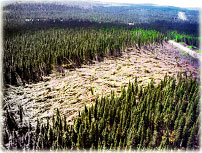 |  |
Blowdown
Blowdown may increase with climate change as storms may become more frequent and intense. Alternate forestry practices (commercial thinning) may reduce the risk of storm damage like that shown below at Christmas Mountains, N.B. in 1994 which felled 30 million trees and cost $100 million.
 Christmas Mountains, N.B. 19994 (Photograph courtesy of Repap New Brunswick Inc.) |
Hardwood decline
Under climate change, periods of mid-winter thaw may become more frequent and extended. Such events are known to increase air bubble formation in the stems, which if not removed can prevent flow of water to the twigs and leaves in the spring. Air bubbles are removed by spring-time root pressure; however, if snowpack is removed by extended thaws, refreezing of the soil may damage the roots. Air-filled stems are thus not refilled with water, resulting in dieback. The well documented extensive dieback and decline of birches in northeatern North America in the 1930s and 1940s was explained at the time but may have been due to such climate extremes.
Did you know?
More than 58 thousand people are employed; directly and indirectly, in the forest industry in the four Atlantic provinces, producing goods valued at more than $5.6 billion in 1996.
 What will happen to our forests with an increase in winter thaws as our winters become warmer?
What will happen to our forests with an increase in winter thaws as our winters become warmer?
Invasive insects
 Invasive insects (PPhotograph courtesy of U.S. Department of Agriculture) |
Gypsy moth, Lymantria dispas (L.), is one of the many introduced forest insects found in Atlantic Canada. The map shows changes in distribution of the flightless female and/or eggs and larvae, from 1981-1996.
Gypsy moth has rarely caused more than trace defoliation in Atlantic Canada, however it likes hardwood foliage and is potentially a risk to these species. Winter temperature increase is a critical limitation to development and survival of this month, as eggs are killed on prolonged exposure to temperatures at or below -9ēC, and -23ēC for even short periods is lethal.
Diligence is required to reduce the risk to our forests from introduced insects such as gypsy moth, especially as winter temperatures rise.
 Gypsy moth incidence in Atlantic Canada (Source : Canadian Forest Service) |
| 2006-10-06 |